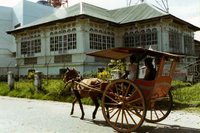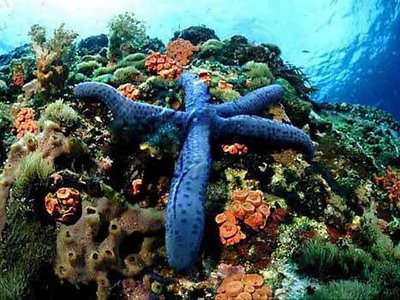 I have never tried diving yet although I have always wanted to. And obviously, with so much marine biodiversity in the Philippines, I'm missing a lot. The closest thing I've ever done was walk a few meters from the shore in full scuba gear during a high school class outing in the Eagle Point Resort in Batangas. We also got to snorkel off the coast of Anilao, close to Maricaban and Sombrero Islands. But that was it.
I have never tried diving yet although I have always wanted to. And obviously, with so much marine biodiversity in the Philippines, I'm missing a lot. The closest thing I've ever done was walk a few meters from the shore in full scuba gear during a high school class outing in the Eagle Point Resort in Batangas. We also got to snorkel off the coast of Anilao, close to Maricaban and Sombrero Islands. But that was it.
 Which is why I was encouraged further when I found out that the Verde Island Passage, which was just a few kilometers away, is now recognized by scientists as "the center of the center of the center of the world's marine shore fish biodiversity."Just to give everyone a backgrounder on the title, the Sulu-Sulawesi Seascape is recognized by the scientific community as the center of the highest concentration of marine biodiversity in the world. Occupying an area of 900,000 square kilometers in the Philippines, Indonesia and Malaysia, it is "at the heart of the coral triangle which accounts for 50 percent of the world’s coral reefs," a Philippine Daily Inquirer article reported.
Which is why I was encouraged further when I found out that the Verde Island Passage, which was just a few kilometers away, is now recognized by scientists as "the center of the center of the center of the world's marine shore fish biodiversity."Just to give everyone a backgrounder on the title, the Sulu-Sulawesi Seascape is recognized by the scientific community as the center of the highest concentration of marine biodiversity in the world. Occupying an area of 900,000 square kilometers in the Philippines, Indonesia and Malaysia, it is "at the heart of the coral triangle which accounts for 50 percent of the world’s coral reefs," a Philippine Daily Inquirer article reported.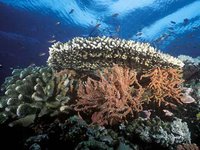 Comparative studies of marine concentration in the Indo-Malaya-Philippines archipelago show that central Philippines, which includes the Tubattaha Reef, a UNESCO world heritage site, is the center of that center of marine biodiversity. It was American marine biologist Kent Carpenter of the World Conservation Union, and fellow researcher Victor Springer of the Smithsonian Institution who discovered in 2004 that the center of the center of marine shore fish biodiversity in the world was the Philippines, and not Indonesia.
Comparative studies of marine concentration in the Indo-Malaya-Philippines archipelago show that central Philippines, which includes the Tubattaha Reef, a UNESCO world heritage site, is the center of that center of marine biodiversity. It was American marine biologist Kent Carpenter of the World Conservation Union, and fellow researcher Victor Springer of the Smithsonian Institution who discovered in 2004 that the center of the center of marine shore fish biodiversity in the world was the Philippines, and not Indonesia. And it was determined that the center of the center of the center of that marine biodiversity was the Verde Island Passage corridor, which was found to have the largest concentration of marine life in the world with a recorded 1,736 overlapping marine species in a 10 by 10 kilometer area. Verde Island is thus dubbed by scientists as "the world’s blue water version of the Amazon River basin."
And it was determined that the center of the center of the center of that marine biodiversity was the Verde Island Passage corridor, which was found to have the largest concentration of marine life in the world with a recorded 1,736 overlapping marine species in a 10 by 10 kilometer area. Verde Island is thus dubbed by scientists as "the world’s blue water version of the Amazon River basin."
For more information, check out the article RP world center of marine treasures. Looks like I'll consider diving in the near future. Hehe! (Photos from Scott Tuason; Diving in the Philippines and Yvette Lee, PDI)

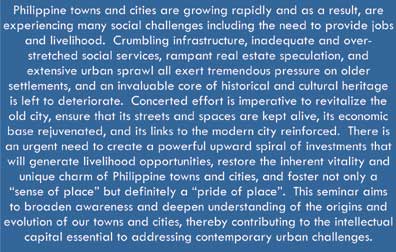 The Heritage Conservation Society (HCS), in collaboration with the Urban Partnerships Foundation, and the University of the Philippines History Department, is organizing Philippine Towns & Cities: reflections of the past, lessons for the future, a seminar which aims to promote heritage conservation as a strategy for urban development and revitalization that will redound to local socioeconomic growth.A strategic starting point for this is to document the history and evolution of Philippine human settlements – how and why they were established, planned, developed, and grew in the manner that they have and in the places where they are.From this documentation, lessons can be extracted that can help guide policies and approaches for the planning and management of future urban development and revitalization with a strong heritage conservation component.
The Heritage Conservation Society (HCS), in collaboration with the Urban Partnerships Foundation, and the University of the Philippines History Department, is organizing Philippine Towns & Cities: reflections of the past, lessons for the future, a seminar which aims to promote heritage conservation as a strategy for urban development and revitalization that will redound to local socioeconomic growth.A strategic starting point for this is to document the history and evolution of Philippine human settlements – how and why they were established, planned, developed, and grew in the manner that they have and in the places where they are.From this documentation, lessons can be extracted that can help guide policies and approaches for the planning and management of future urban development and revitalization with a strong heritage conservation component.
For registration and further information, please contact:
Ms. Dorie Soriano (Heritage Conservation Society; Tel.: 521-2239; Email: hcs_secretariat@yahoo.com)
Mrs. Virginia R. Rodriguez (The Urban Partnerships Foundation; Tel: 895-1812/896-1902; Email: deinsiedel.upf@gmail.com)
Here is a press release for the state funeral for National Artist for Architecture Pablo S. Antonio. Everyone is invited to attend the ceremonies at the Libingan ng Mga Bayani which will begin shortly before 12 noon on Friday, October 20, 2006.
Update: The widow of Pablo S. Antonio passed away October 10, 2006. The state funeral has been postponed to next month and is tentatively scheduled for November 24, 2006.
State funeral for National Artist Pablo S. Antonio
Pablo S. Antonio, who was posthumously awarded National Artist for Architecture in 1976, will be given a state funeral on Friday, October 20, 2006 and his remains transferred to the Libingan ng Mga Bayani on that day. His widow, 96-year old Marina R. Antonio, will be the recipient of the flag in the formal military ceremony.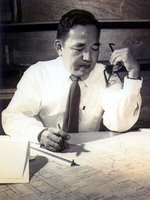 The remarkable life of Antonio is one of determination triumphing over adverse circumstances. Born on January 25, 1902 and orphaned at an early age, the young Antonio worked at the Bureau of Public Works while still in high school in order to put himself through school. Dropping out of college for the opportunity to work on the construction of the former Legislative Building (now the National Museum), his brilliance was noted by Engineer Ramon Arevalo who paid for him to study architecture at the University of London. Having worked while studying for many years, Antonio was so adept at the practicalities of construction that he completed the five year course in just three.Upon returning to Manila he immediately embarked on a career spanning four decades, with many of his greatest works built from the very beginning—the old Ideal Theater, the Far Eastern University buildings, the beautiful Ramon Roces Publications building (still standing on Soler corner Calero, Quiapo) and the White Cross Orphanage on Santolan Road where it has been recently confirmed that the relief in front of the building is by Italian sculptor Francesco Monti. Post-war, his works include the Manila Polo Club, original Manila Golf building, the first houses of Forbes Park and many more.A book on his life and works has been completed and is beginning to go into production. Being published by Vibal Publishing, it is slated to be launched on January 25, 2007, Antonio’s birth anniversary. The book will share with the public the inspiring story of his life and works. In order to cover manuscript costs, advance orders for the book are being taken. Those who prepay for their copies now get their names printed in the book as supporters of the project. For inquiries contact project editor Vicky Veloso-Barrera at 4102279, (0916) 5165035 or at tiny_planet@hotmail.com.It is the hope of the Antonio family and other avid conservationists that with the release of the book more awareness would be created of our country’s cherished landmarks, and that those under threat, including Antonio’s Manila Polo Club, be preserved and protected.
The remarkable life of Antonio is one of determination triumphing over adverse circumstances. Born on January 25, 1902 and orphaned at an early age, the young Antonio worked at the Bureau of Public Works while still in high school in order to put himself through school. Dropping out of college for the opportunity to work on the construction of the former Legislative Building (now the National Museum), his brilliance was noted by Engineer Ramon Arevalo who paid for him to study architecture at the University of London. Having worked while studying for many years, Antonio was so adept at the practicalities of construction that he completed the five year course in just three.Upon returning to Manila he immediately embarked on a career spanning four decades, with many of his greatest works built from the very beginning—the old Ideal Theater, the Far Eastern University buildings, the beautiful Ramon Roces Publications building (still standing on Soler corner Calero, Quiapo) and the White Cross Orphanage on Santolan Road where it has been recently confirmed that the relief in front of the building is by Italian sculptor Francesco Monti. Post-war, his works include the Manila Polo Club, original Manila Golf building, the first houses of Forbes Park and many more.A book on his life and works has been completed and is beginning to go into production. Being published by Vibal Publishing, it is slated to be launched on January 25, 2007, Antonio’s birth anniversary. The book will share with the public the inspiring story of his life and works. In order to cover manuscript costs, advance orders for the book are being taken. Those who prepay for their copies now get their names printed in the book as supporters of the project. For inquiries contact project editor Vicky Veloso-Barrera at 4102279, (0916) 5165035 or at tiny_planet@hotmail.com.It is the hope of the Antonio family and other avid conservationists that with the release of the book more awareness would be created of our country’s cherished landmarks, and that those under threat, including Antonio’s Manila Polo Club, be preserved and protected.
 I just came back from a trip to Isabela where I attended the 2nd Nuang Festival in the town of San Agustin upon the invitation of my SSEAYP batchmate Vice-Mayor Jules Lamug, whom I heard is currently the youngest vice-mayor in the country. San Agustin is the southernmost town of Isabela. But to get to it, you have to pass by Santiago City and the towns of Echague and Jones.Although the roads to Echague and Jones are well-paved, once you leave the poblacion of Jones, you will have to drive through rough and muddy roads going to the town. Good thing there are new bridges being constructed since the current ones are too low and are easily susceptible to bridge closures when the waters of the Cagayan River overflow.
I just came back from a trip to Isabela where I attended the 2nd Nuang Festival in the town of San Agustin upon the invitation of my SSEAYP batchmate Vice-Mayor Jules Lamug, whom I heard is currently the youngest vice-mayor in the country. San Agustin is the southernmost town of Isabela. But to get to it, you have to pass by Santiago City and the towns of Echague and Jones.Although the roads to Echague and Jones are well-paved, once you leave the poblacion of Jones, you will have to drive through rough and muddy roads going to the town. Good thing there are new bridges being constructed since the current ones are too low and are easily susceptible to bridge closures when the waters of the Cagayan River overflow.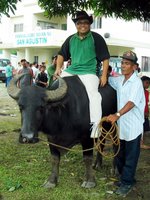 San Agustin is the top producer of Murrah buffaloes in the entire country which is why every September 27, a day before their foundation day or town fiesta, they hold the Nuang Festival, nuang is Ilocano for buffalo, to celebrate this feat.This was not anything like the lavish city and provincial festivals that have become by-words of Philippine tourism. I guess it was a chance for me to experience a small town fiesta since the activities planned were the way most towns in the country celebrated their fiesta in the good old days.
San Agustin is the top producer of Murrah buffaloes in the entire country which is why every September 27, a day before their foundation day or town fiesta, they hold the Nuang Festival, nuang is Ilocano for buffalo, to celebrate this feat.This was not anything like the lavish city and provincial festivals that have become by-words of Philippine tourism. I guess it was a chance for me to experience a small town fiesta since the activities planned were the way most towns in the country celebrated their fiesta in the good old days. The morning started with street dancing and a parade of buffaloes around the town. Each buffalo had a number since there were competitions to determine the best bred F1, as the Murrah buffalo is referred to. This was followed by native games for the kids such as sack races with bags of groceries at stake, as well as a pig catching contest, the prize being the poor greased piglet which the kids tried to catch. There was also a buffalo talent contest with the buffalo which could do the most tricks winning the competition. To break the tie, the buffalos were asked to sit down with the fastest being declared the winner.
The morning started with street dancing and a parade of buffaloes around the town. Each buffalo had a number since there were competitions to determine the best bred F1, as the Murrah buffalo is referred to. This was followed by native games for the kids such as sack races with bags of groceries at stake, as well as a pig catching contest, the prize being the poor greased piglet which the kids tried to catch. There was also a buffalo talent contest with the buffalo which could do the most tricks winning the competition. To break the tie, the buffalos were asked to sit down with the fastest being declared the winner.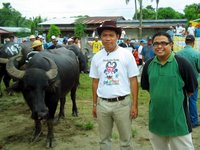 Like in most small towns, the afternoon was reserved for the siesta which is what I did. Hehe! And a small town fiesta would not be complete without basketball games in the town plaza.I was surprised that an old pre-war tradition was still being done in San Agustin. Unlike the current fiestas were we hold beauty pageants, San Agustin still organizes a carnival queen or popularity contest. Jules and I were kidding about it since they reverted back to the “dark ages.” Haha! The winner of the competition was the candidate who got the most number of votes, with each vote being purchased. And the coronation night was simply that since the winners were already pre-determined.The entire town was literally there to watch the event. Traditional dances performed by the various schools of San Agustin opened the coronation night. Then each of the winners was called to march together with their consorts and entourage of flower girls, angels, as well as crown, scepter and sash bearers all in complete carnival queen regalia, up stage where their thrones were waiting for them. This is how pageants used to be done in the old days.
Like in most small towns, the afternoon was reserved for the siesta which is what I did. Hehe! And a small town fiesta would not be complete without basketball games in the town plaza.I was surprised that an old pre-war tradition was still being done in San Agustin. Unlike the current fiestas were we hold beauty pageants, San Agustin still organizes a carnival queen or popularity contest. Jules and I were kidding about it since they reverted back to the “dark ages.” Haha! The winner of the competition was the candidate who got the most number of votes, with each vote being purchased. And the coronation night was simply that since the winners were already pre-determined.The entire town was literally there to watch the event. Traditional dances performed by the various schools of San Agustin opened the coronation night. Then each of the winners was called to march together with their consorts and entourage of flower girls, angels, as well as crown, scepter and sash bearers all in complete carnival queen regalia, up stage where their thrones were waiting for them. This is how pageants used to be done in the old days.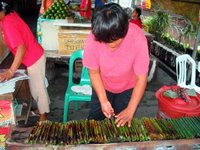 Anyway, the next day, the town fiesta, was marked by a grand parade with the queen and her court paraded around town on decorated floats. I didn’t stay too long since Milenyo was soon to unleash its wrath and I wanted to be back in Pampanga before it did.And of course, since I was up north, I made it a point to eat tupig, their native kakanin, which is glutinous rice and other ingredients rolled up in a banana leaf and roasted over a metal plate on top of charcoal. So I ate some at stopovers on the way to Isabela and back home.Cabanatuan tricycles are cheats!As an aside to my story, here is a warning to travelers who may by chance find themselves in Cabanatuan City… beware of the tricycle drivers because they are cheats! On my way to Isabela, the tricycle I rode charged me PHP120 for a ride from the terminal to some point in the national highway! I tried to argue with him about it. But my mistake was I didn’t ask the price before I boarded so I had to settle for PHP80. The bastard!I thought it was an isolated incident but on my way back to Pampanga, I took another tricycle in Cabanatuan from McDonald’s to the bus terminal which was about a kilometer or two away. This time, I asked how much. When he said PHP30, I frowned and walked away. Then he shouted PHP20 so I said yes. When I got off at the terminal, I gave him a PHP50 bill and he said I still lacked ten pesos. When I protested, he said it’s PHP20 but I had to pay for three people since I was alone in the tricycle!This time I didn’t allow it and protested until he gave me the right change. Imagine, they charge even more than what an air-conditioned taxi would charge for the same distance. The nerve!These incidents also show how remiss the local government in Cabanatuan City is in regulating and disciplining the tricycles there. Lest they forget they are notorious for having the most number of tricycles in the entire country, the City Government of Cabanatuan should then ensure that incidents like these would not happen by (1) requiring every tricycle to have a fare schedule posted for passengers to see and refer to, (2) posting fare schedules on billboards in tricycle terminals, (3) creating a hotline for complaints with contact numbers conspicuously posted inside the tricycles beside their registration number, and (4) imposing strict disciplinary measures for erring drivers and the associations they are part of (imposing measures on the associations will ensure that members will regulate their ranks).
Anyway, the next day, the town fiesta, was marked by a grand parade with the queen and her court paraded around town on decorated floats. I didn’t stay too long since Milenyo was soon to unleash its wrath and I wanted to be back in Pampanga before it did.And of course, since I was up north, I made it a point to eat tupig, their native kakanin, which is glutinous rice and other ingredients rolled up in a banana leaf and roasted over a metal plate on top of charcoal. So I ate some at stopovers on the way to Isabela and back home.Cabanatuan tricycles are cheats!As an aside to my story, here is a warning to travelers who may by chance find themselves in Cabanatuan City… beware of the tricycle drivers because they are cheats! On my way to Isabela, the tricycle I rode charged me PHP120 for a ride from the terminal to some point in the national highway! I tried to argue with him about it. But my mistake was I didn’t ask the price before I boarded so I had to settle for PHP80. The bastard!I thought it was an isolated incident but on my way back to Pampanga, I took another tricycle in Cabanatuan from McDonald’s to the bus terminal which was about a kilometer or two away. This time, I asked how much. When he said PHP30, I frowned and walked away. Then he shouted PHP20 so I said yes. When I got off at the terminal, I gave him a PHP50 bill and he said I still lacked ten pesos. When I protested, he said it’s PHP20 but I had to pay for three people since I was alone in the tricycle!This time I didn’t allow it and protested until he gave me the right change. Imagine, they charge even more than what an air-conditioned taxi would charge for the same distance. The nerve!These incidents also show how remiss the local government in Cabanatuan City is in regulating and disciplining the tricycles there. Lest they forget they are notorious for having the most number of tricycles in the entire country, the City Government of Cabanatuan should then ensure that incidents like these would not happen by (1) requiring every tricycle to have a fare schedule posted for passengers to see and refer to, (2) posting fare schedules on billboards in tricycle terminals, (3) creating a hotline for complaints with contact numbers conspicuously posted inside the tricycles beside their registration number, and (4) imposing strict disciplinary measures for erring drivers and the associations they are part of (imposing measures on the associations will ensure that members will regulate their ranks).
 I have never tried diving yet although I have always wanted to. And obviously, with so much marine biodiversity in the Philippines, I'm missing a lot. The closest thing I've ever done was walk a few meters from the shore in full scuba gear during a high school class outing in the Eagle Point Resort in Batangas. We also got to snorkel off the coast of Anilao, close to Maricaban and Sombrero Islands. But that was it.
I have never tried diving yet although I have always wanted to. And obviously, with so much marine biodiversity in the Philippines, I'm missing a lot. The closest thing I've ever done was walk a few meters from the shore in full scuba gear during a high school class outing in the Eagle Point Resort in Batangas. We also got to snorkel off the coast of Anilao, close to Maricaban and Sombrero Islands. But that was it. Which is why I was encouraged further when I found out that the Verde Island Passage, which was just a few kilometers away, is now recognized by scientists as "the center of the center of the center of the world's marine shore fish biodiversity."
Which is why I was encouraged further when I found out that the Verde Island Passage, which was just a few kilometers away, is now recognized by scientists as "the center of the center of the center of the world's marine shore fish biodiversity." Comparative studies of marine concentration in the Indo-Malaya-Philippines archipelago show that central Philippines, which includes the Tubattaha Reef, a UNESCO world heritage site, is the center of that center of marine biodiversity. It was American marine biologist Kent Carpenter of the World Conservation Union, and fellow researcher Victor Springer of the Smithsonian Institution who discovered in 2004 that the center of the center of marine shore fish biodiversity in the world was the Philippines, and not Indonesia.
Comparative studies of marine concentration in the Indo-Malaya-Philippines archipelago show that central Philippines, which includes the Tubattaha Reef, a UNESCO world heritage site, is the center of that center of marine biodiversity. It was American marine biologist Kent Carpenter of the World Conservation Union, and fellow researcher Victor Springer of the Smithsonian Institution who discovered in 2004 that the center of the center of marine shore fish biodiversity in the world was the Philippines, and not Indonesia. And it was determined that the center of the center of the center of that marine biodiversity was the Verde Island Passage corridor, which was found to have the largest concentration of marine life in the world with a recorded 1,736 overlapping marine species in a 10 by 10 kilometer area. Verde Island is thus dubbed by scientists as "the world’s blue water version of the Amazon River basin."
And it was determined that the center of the center of the center of that marine biodiversity was the Verde Island Passage corridor, which was found to have the largest concentration of marine life in the world with a recorded 1,736 overlapping marine species in a 10 by 10 kilometer area. Verde Island is thus dubbed by scientists as "the world’s blue water version of the Amazon River basin."

